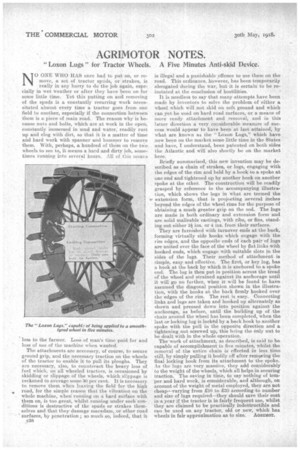AGRIMOTOR NOTES.
Page 16

If you've noticed an error in this article please click here to report it so we can fix it.
" Loxon Lugs" for Tractor Wheels. A Five Minutes Anti-skid Device.
N0 ONE WHO HAS once had to put on, or remove, a set of tractor spuds, or strakes, is really in any hurry to do the job again, especially in wet weather or after they have been on for same little time. Yet this putting on and removing of the spuds is a constantly recurring work necessitated almost every time a tractor goes from one field to another, especially if the connection between them is a pieca of main road. The reason why is because nuts and bolts, which are at work in the open, constantly immersed in mud and water; readily rust up and clog with dirt, so that it is a matter of time add hard work with spanner and hammer to remove them. With,. perhaps, a hundred of them on the two wheels to see to, it means a hard and dirty job, sometinies running into sc.veral hours. L',11 of this Means
losa to the farmer. Loss. of man's time paid for and loss of use of the machine when wanted.
The attachments are necessary, of course, to secure ground grip, and the necessary traction on the wheels of the tractor to enable it to pull its ploughs.. They are necessary,. also, to counteract the heavy loss of
• fuel which, onall 'wheeled tractors, is occasioned by • skidding or slippage of the wheelS, which slippage is reckoned to average some 30 per cent. It is necessary to remove theta., when leaving the field for the high road, for the simple reason that the vibration on the whole machine; when running on a hard surface with them oh, is too great, whilst running under such conditions is destructive of the spuds or strakes themselves and that they damage macadam, or other road surfaces, by penetration ; so much so, indeed, that it
c38 is illegal and a punishable offence to use them on the read. This ordinance. however, has been temporarily abrogated during the War, but it is certain to be reinstated at the conclusion of hostilities.
It is needless ta say that many attempts have been made by inventors to solve the problem of either a Wheel which will not skid on soft ground and which. can yet be used on hard road surfaces, or a means of more ready attachment and removal,. and in this latter direction .a very 'considerable measure of success .would appear to have been at last attained, by what are known as the " Lexon Lugs," which have now been on the market some little time in the States and have, I understand, been patented on both sides the Atlantic and Will also shortly be on 'the market here.
Briefly summarized, this new invention may be described as a chain of strakes, or lugs, engaging with the edges of the rim and "held by a hook to a spoke at one end and tightened up by another hook on another spoke at the other. The construction will be readily grasped by reference to the accompanying illustraLien, which shows the Jugs in what. are termed the ,extension form, that is proje.cting several 5.nehes beyond the edges of the wheel rims for the purpose of obtaining a much greater grip on the sod. The lugs are made in both ordinary and extension form and are solid malleable castings, with ribs, or fins, standing out either 2 ins. or 4 ins, from their surfaces. '
They are furnished with turnover ends at the back, forming virtually side hooks which engage with the rim edges, and the opposite ends of each pair of lugs are united over the face of the wheel by flat links with hooked ends, which engage with suitable slots n the sides of the lugs. Their method of attachment is simple, easy and effective, The first, or key lug, has a hook at the back by which itis anchored ta a spoke end. The lug is then put in position across the tread of the wheel and strained against its anchorage unpil it will go no further, when itwill be found to have assumed the diagonal position hown in_ the illustration, with the hooks at the b.ack firmly hooked over. the edges of the rim. The rest is easy. Connecting links_ and lugs are taken and hooked up alternately as shown and pressed down into position against the anchorage, as before, until the building up of the chain around the wheel has been completed, when the last or locking lug is locked by a back hook to another 'spoke with the pull in the opposite olirectien and a. tightening nut screwed up,. this being the only nut to be dealt with in the whole operation.
Thenvork of attachment, as described, is said to be capable of accomplishment in five minutes, whilst the remoYal of the 'entire chain is effected, in less time still, by simply pulling it bodily off after removing the final locking hook from its attachment to the spoke. As the lugs are very masaive, they add considerably to the, weight of the wheels, which all helps in securing traction.' The saving in time, to say nothing of temper and hard work, is considerable, and although, on account of the weight of metal employed, they.are not cheap—varying from £10 to £30 according-to number and size of lugs require,d---they should save their cost in a year if the tractor is in fairly frequent use, whilst they are claimed to be practically indestructible and can be used on. any tractor, old or new, Which has wheels in fair approximation as to size. AGRIMOT.






















